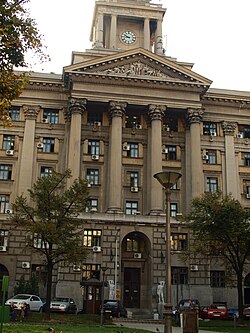Ministry of Transport building in Belgrade
| Ministry of Transport | |
|---|---|
 The Ministry of Transport |
|
| Data | |
| place | Belgrade |
| builder | Svetozar Jovanović |
| Construction year | 1927-1931 |
| Coordinates | 44 ° 48 '21 " N , 20 ° 27' 30" E |
| particularities | |
| Seat of Železnice Srbije | |
The building of the Ministry of Transport in Belgrade was built by Svetozar Jovanović, a representative of post-academicism with elements of neoclassicism , in 1927–31. After its construction, the 600-room building was for a time the largest public building on the Balkan Peninsula. From 1931 until the completion of the Yugoslav Parliament, the Skupština , part of the building served as the meeting place of the Senate in the Kingdom of Yugoslavia until 1936. The building covers one block on Birčaninova and Nemanjina ulica and has been included in the register of Belgrade's historically important buildings.
Today it serves entirely as the headquarters of Železnice Srbije . The Railway Museum of Serbia has been located in one part since 1950.
During the Second World War, as the headquarters of the Commander-in-Chief Southeast, it was a focal point in the liberation struggle from the National Socialist occupation during the Belgrade operation.
architecture
The building in the style of academic classicism shows the central motif of a tympanum divided by four pseudo-Corinthian columns , above which a clock tower rises. The four facades are structured by colonnades and columns. 6 unadorned inner courtyards and 600 rooms, among which a large assembly hall stands out, as well as the sculptural decoration in which, among others, Toma Rosandić was involved, must still be listed.
history
During the German occupation of 1941–1944, the headquarters of the Military Commander Southeast was located in the building of the Ministry of Transport . First, the German military command was carried out by Alexander Löhr , then by Field Marshal Maximilian von Weichs . As the headquarters of Army Group E, which has been set up since 1943, as well as that of Army Group F , it was massively defended during the offensive of the advancing 3rd Ukrainian Front of the Red Army for the liberation of Serbia in the Belgrade operation and formed in urban warfare after the internal defense lines had broken through on 15 October 1944 an important German base that was supposed to secure the withdrawal of Army Group E from the Balkans.
The heaviest battles during the liberation of Belgrade were fought around the building with the adjoining ministries in Nemanja ulica, as well as the entrances to the nearby train station area and main train station . The Soviet troops and Yugoslav partisans were not able to take the Ministry of Transport as part of the Wehrmacht's last internal line of defense until October 19, after some bloody house-to-house fighting. After the defeat, the German withdrawal from Belgrade took place on October 19 via the bridgeheads held by them at the Sava crossings to Syrmia.
swell
- ↑ arte.rs
- ↑ beogradskonasledje.rs
- ↑ beogradska.blog.rs
- ↑ Vecernje novosti, 23. October 2009 Svaka zgrada tvrdjava
- ↑ arte.rs
- ↑ znaci.net
- ↑ Politika, October 19, 2009 Beogradska operacija velika pobeda

